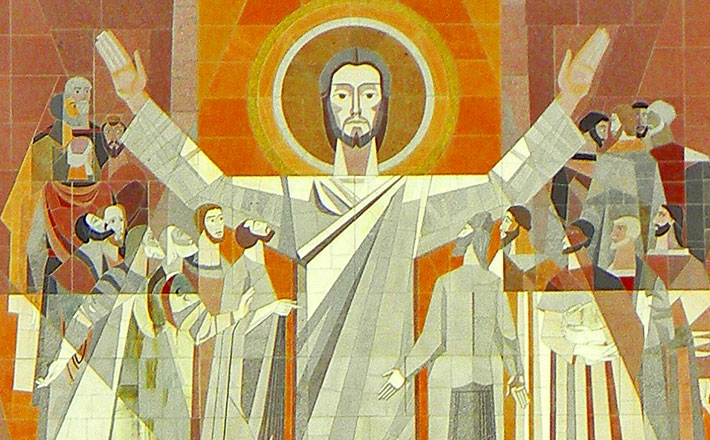Commentary on 1 John 5:9-13
First John, in some ways, is like a commentary on the meaning of the Fourth Gospel, but in other ways it is like a catechism.
For example, the Elder1 likes to raise questions that his readers are struggling with and then he answers them carefully and concisely. In chapter five, the Elder focuses his attention on the person of Jesus as Son of God and giver of life. In order to make full sense of this chapter, the reader should notice the frequent use of testimonial language. The Elder treats the truth of Jesus as if it is on trial and he must make his case and invite the proper witnesses.
The lectionary reading focuses on 1 John 5:9-13, but the epistolary section begins with 1 John 5:6-8: “This [Son of God] is the one who came by water and blood, Jesus Christ, not with the water only but with the water and the blood. And the Spirit is the one that testifies, for the Spirit is the truth. There are three that testify: the Spirit and the water and the blood, and these three agree.”
Many Johannine scholars agree that the Elder, a leader of a certain Johannine community, is addressing the statements of certain dissenters who are throwing his readers into confusion. It is clear enough that, here in 1 John 5:6-8, there is some controversy over whether Jesus Christ came by water (referring to his unique Spirit-endowment for ministry and Sonship at his baptism) alone, or whether also by his blood (no doubt a metonym pointing to his crucifixion). It is possible these dissenters had certain gnostic tendencies whereby they prioritized the spirituality, heavenliness, and divinity of Jesus, and denied or downplayed what was related to his mortality, suffering, human shame, and death. In such a case, the Elder was affirming to his community the centrality of Jesus’ fully human life and his real human death.
In order to appreciate just how controversial this would be in the first century, we must understand two things. Firstly, the anticipated Jewish “messiah” was expected to be a triumphal figure, an invincible superhero for his people. How could such a man be “bested” by his enemies? Secondly, it made a huge difference how Jesus-the-messiah died. If he died nobly in battle, at least he would be remembered for his bravery. But crucifixion was the absolute worst way to die. The Romans did not invent crucifixion, but they perfected its effects — it was the single most powerful way to obliterate someone’s dignity and honor. No wonder Jews found it to be a stumbling block and scandal to think of a crucified messiah (1 Corinthians 1:23).
But the Elder does not shy away from attributing to “the blood” the ultimate importance. In 1 John 5:5, the Elder asks, who is it that overcomes the world? The dissenters may have answered that it is “God,” or perhaps even “the Son of God.” The Elder wants to place emphasis in his letter on Jesus Christ whose blood was shed. The question and answer, put in that way, introduces a paradox. How do you normally overcome an enemy? By force, of course. By power, by superior weapons of war, by will to dominate. The Elder offers his surprising answer: by the cross. The cross is victory. There is power in the blood.
Huh?
This would prove to be a hard lesson for many Christians in the first century. It required such backward thinking to see power and victory in the death of Jesus. What Christians eventually came to realize is that the cross was not a failure on the part of Jesus. As Paul reminds us in Philippians 2:5-11, Jesus chose his own path in full obedience to God, humbling himself, taking on the form of a slave, and his unswerving obedience led to the cross.
It might seem strange to feature a lectionary text on “the blood” during the season of Easter, but in fact it ought to be a reminder that when we move from “Good Friday” to “Easter Sunday” we do not leave the cross behind as if the resurrection erases it. The cross was not a mistake covered over by the resurrection. The testimony of the apostles teaches us that the cross was the climax of Jesus’ obedience to God the Father and his full love for the world. While his sacrifice was pervasively labeled as shame and degradation by the world, when God raised Jesus up from the realm of the dead, He placed His own stamp of approval on Jesus’ gift of his life. The resurrection does not replace the cross of Christ, it shines a spotlight on the cross to broadcast the victory of God to the world.
Today, it is not as common to hear Christians deny the humanity of Jesus, or to scorn his death. But problems with a similar misunderstanding of the way of Jesus appear in every generation. To give a recent example, in April of 2014, a woman in North Carolina called the police having noticed a homeless man sleeping on a bench outside of a church that she drives by on the way home from work. The woman and the police discovered that this “homeless man” was actually a statue of a humble Jesus, commissioned by the church and sculpted by Catholic artist Timothy Schmalz.
The woman was scandalized by this statue, finding it an offensive portrayal of Jesus: “Jesus is not a vagrant, Jesus is not a helpless person who needs our help,” she told reporters. This woman’s voice, I think, has echoed through the ages as someone who wants to claim a supernatural Jesus to the exclusion of the man of the cross. His own did not receive him (John 1:11). He needed help from others (Matthew 4:11). He had no place to lay his head (Matthew 8:20). His lifeless body was taken down from the cross (Luke 23:53). He was crucified in weakness …
… But lives by the power of God. For we are weak in him, but in dealing with you we will live with him by the power of God (2 Corinthians 13:4).
Notes:
1 The author of 1 John is conventionally called “the Elder” in scholarship.


May 17, 2015